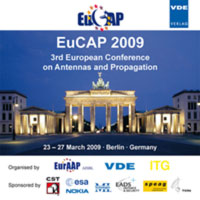Incremental Beam Diffraction from Flat Reflectors
Conference: EuCAP 2009 - 3rd European Conference on Antennas and Propagation
03/23/2009 - 03/27/2009 at Berlin, Germany
Proceedings: EuCAP 2009
Pages: 4Language: englishTyp: PDF
Personal VDE Members are entitled to a 10% discount on this title
Authors:
Carluccio, Giorgio; Albani, Matteo; Maci, Stefano (Department of Information Engineering, University of Via Roma 56, 53100, Siena, Italy)
Abstract:
Complex Point Source (CPS) method provides a powerful mathematical tool to represent a beam. A CPS is a solution of the Helmholtz wave equation obtained by the analytical continuation of the free-space Green’s function for complex position of the point source. Its paraxial approximation leads to a Gaussian Beam field. In this paper, the total field in the space surrounding a flat large reflector illuminated by a CPS is given in terms of a line integration along the analytical continuation, into the complex space, of the edge boundary discontinuities. By this continuation the incremental contributions become beams that exhibit an intrinsic directivity. Furthermore, the incremental contributions are regular and continuous at any observation aspect. This feature leads to increase the numerical efficiency of the integration process. The formulation is very simple and leads to accurate results, except for grazing angle of incidence and observation, where higher order diffraction mechanisms have to be considered. The presented formulation is successfully validated by comparison against the solution obtained by the Incremental Theory of Diffraction for CPS illumination previously developed, in which the integration process is performed along the real actual edge discontinuities, where the incremental contributions present a spherical wave behaviour.


